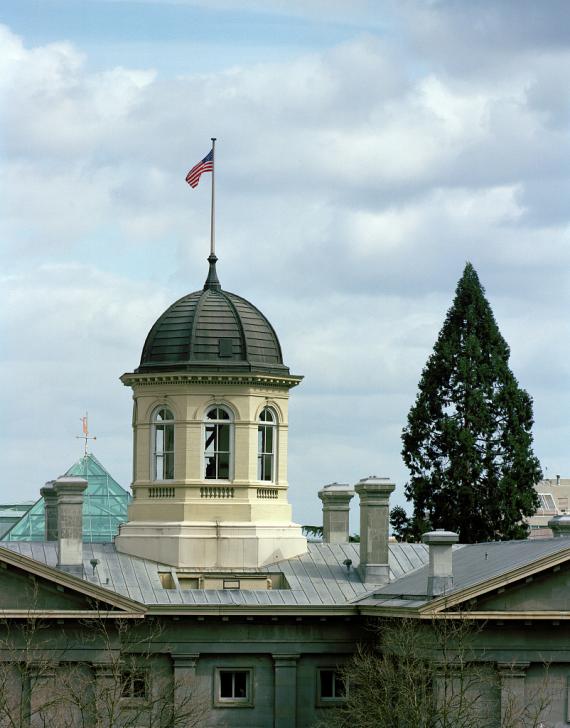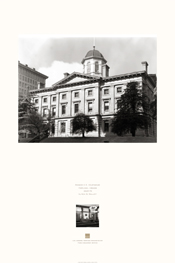Location: 700 SW 6th Ave, Portland, OR 97204
History
The Pioneer Courthouse is the oldest extant federal building in the Pacific Northwest. Design began in 1869 during Alfred B. Mullett’s (1834-1890) term as the Supervising Architect of the Treasury (1866-1874). Although similar in design to other work by Mullett, two local men, E.B. St. John and John H. Holman, contributed to the building’s appearance. Completed in 1875, the Pioneer Courthouse presents a dignified Italianate design following the precedents of civic architecture in both San Francisco and Portland.
In 1869 the Portland City Council authorized Mayor Hamilton Boyd to sell Block 172 to the U.S. Government for $15,000. At the time, the federal government was criticized for locating the U.S. Courthouse and Post Office so far from the center of town. The building cost $396,500 to construct and was officially completed on October 1, 1875. The Pioneer Courthouse was designed to accommodate all necessary offices and services of the Federal Government in Portland. It housed the U.S. Post Office on the first floor and the Federal Court on the second floor. Other offices included U.S. Customs Service and the Assessor and Collection offices of the U.S. Internal Revenue Service. The third floor contained adjunct offices, while the basement was used for employee facilities and storage.
In 1902 the U.S. Congress approved $200,000 for remodeling and a large addition. The addition by Supervising Architect James Knox Taylor doubled the size of the basement and first floor and created two wings at the second and third floors. The infamous Oregon Land Fraud trials of 1904 were held in the building. Special Federal prosecutor Francis Heney brought 33 criminals to justice, charging Senator John H. Mitchell and Representative John Williamson with plundering Federal lands, state school lands, and the timber resources of the Siletz Indian Reservation.
In 1933 the U.S. Post Office and Federal Court moved to new quarters at SW Broadway and Main Streets. The building was renamed the Pioneer Post Office and re-opened in early 1937 as a branch postal station. In 1973, after a major rehabilitation for use by the U.S. Court of Appeals for the Ninth Circuit, the building was dedicated as the Pioneer Courthouse. The Pioneer Courthouse was designated a National Historic Landmark in 1977.
Architecture
With its dramatic three-story, classical facade and cupola, the Pioneer Courthouse is the focal point of the Pioneer Square Plaza in downtown Portland. Mullet’s original Italianate design for the building consisted of a rectangular plan and symmetrical exterior. The sandstone faced Courthouse is elevated on its site at the center of a full city block. The park-like setting surrounding the Courthouse is landscaped with mature trees, some of which were planted at the time of construction in 1873.
Each elevation has a projecting bay capped with a classical pediment. These bays were centered on the facade before the 1902 expansion. The first story has rusticated pilasters that flank segmental arched openings. A stone stringcourse separates the first floor from the second and third floors. Smooth Doric pilasters resting on the stringcourse span the second and third floors. Fenestration consists of tall, narrow windows capped with cornices supported by brackets on the second floor and small, simple square windows on the third floor. Crowning the hipped roof are eight stone chimneys and an octagonal wood cupola with arched windows.
Pioneer Courthouse is faced with smooth-cut, Bellingham sandstone from the Roth Stone quarry in Chuckanut, Washington, with abase course of rough-faced Tenino sandstone. Original walls are constructed of basalt squares and rectangles in a broken ashlar pattern with a Tenino sandstone cap. Sandstone and basalt were used for the basement walls, which are over four feet thick in places. The structure of the building above the basement is brick, stone, old growth timber, and steel (from the 1905 addition).
During the major expansion and remodeling between 1902 and 1905, wings consistent with the original design were added to the west elevation, and significant first floor interior modifications were undertaken. The original entry hall was extended to the south facade and a side lobby and registry were added. A new terrazzo and marble bordered floor replaced the original black and white “American” tiles. The original plaster cornice, as well as the grand stair at the north end of the lobby, were retained. The project introduced steel I-beams, cast iron columns, and modern electrical, lighting, and heating systems into the building. The volume of the two-story courtroom remained intact, but was richly refurbished. The courtroom is articulated vertically with colossal Doric pilasters grouped in pairs on the east and west sides and singularly on the north and south sides. A massive entablature, complete with dentil course over the triglyph blocks above each pilaster, frames the ornamental ceiling.
In 1973 the U.S. General Services Administration undertook a major interior rehabilitation project to prepare the building for the U.S. Court of Appeals and as a branch station of the U.S. Post Office. A new east-west central corridor and new post office lobby were created in the former workroom. Non-original materials in the main lobby of the post office were replaced with windows, doors, and paneling to match original finishes. The office spaces on the second and third floors were reconfigured to provide additional offices for judges and clerical staff, hearing rooms, and support areas. In 2002 work commenced on another major rehabilitation and restoration of the building. Major objectives of this rehabilitation include the modernization of systems, seismic retrofitting, and the restoration and maintenance of the “boldness and the elegance of the original building design.”
Significant Events
- 1869-1875: The U.S. Government purchases land from Portland for $15,000 and proceeds to build the U.S. Courthouse and Custom House.
- 1902: The U.S. Congress approves $200,000 plans for renovation and an addition to the west elevation.
- 1934: The U.S. Courthouse is vacated.
- 1937: The building reopens as a branch postal station and is renamed the Pioneer Post Office.
- 1939: The U.S. Congress authorizes the construction of a twenty-story Federal building on the site, but plans never materialize.
- 1969-1973: The building undergoes a major exterior and interior restoration to house the U.S. Court of Appeals and Post Office branch station.
- 1973: The building is renamed Pioneer Courthouse and is listed in the National Register of Historic Places.
- 1977: The Pioneer Courthouse is designated a National Historic Landmark.
- 2002: A major restoration/rehabilitation project is initiated.
Facts
- Architects: Alfred B. Mullett, Supervising Architect of the Treasury James Knox Taylor, Supervising Architect of the Treasury
- Architectural Style: Italianate
- Construction Dates: 1869-1875
- GSA Building Number:
- Landmark Status: National Historic Landmark
- Location: 520 Southwest Morrison Street
- Primary Materials: Bellingham and Tenino sandstone
- Prominent Features: Octagonal wood cupola
Poster Download
Download the poster

 U.S. General Services Administration
U.S. General Services Administration


